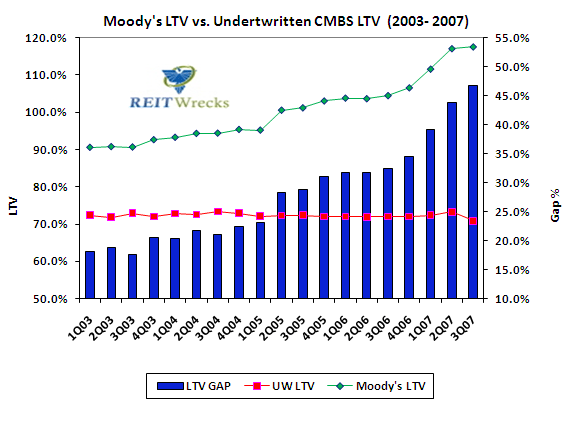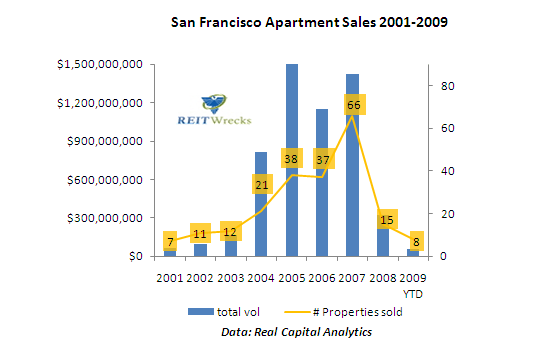Talk about a REIT Wreck. Landing head first in a rock pile would be a much better metaphor for the 2009 commercial real estate market than an explanation for my year-end absence. However, that’s exactly what happened in a biking accident early in November, and my right arm spent the waning days of 2009 bound up in an “immobilizer”. And while it could have been appropriate to begin my recovery with a post on Healthcare REITs, I thought the news coming out of San Francisco multi-family market was much more interesting.
As I noted in my last post, the San Francisco multi-family CMBS default rate rivals that of Detroit. However, the cause is not entirely due to a horrible economy, though Bay Area unemployment now exceeds many areas of the Midwest. In San Francisco, high default rates can be traced more directly to the ebullient capital markets of the boom years, coupled with the strong desire of many institutional lenders to get a piece of the previously impenetrable rock.
As everybody knows now, loose credit enabled many buyers to pay ever higher prices for assets whose cash flows weren’t entirely up to snuff. Combine that with a highly desirable market dominated by mom and pop landlords and their local banks, and you’ve got a recipe for trouble. These chickens are finally coming home to roost in San Francisco, but not in the way I would have expected.
I love this graph from Moody’s, which illustrates how the traditional loan-to-value criteria became more and more relaxed during the boom. Moody’s estimated that the gap between its estimate of actual LTVs and underwritten CMBS LTVs reached a record in the first quarter of 2007 (nearly 45%). The Moody’s estimate of actual LTV also reached a record of 106.5%. Who needed equity when lenders would write you a check for more than the property was worth?

However, Bank of America, UBS and Credit Suisse did not particularly care about the investors in the junior classes of the securities they were selling, only the fees they could earn from originating the loans and structuring the bonds. Armed with the ability to sell down their loan exposure to investors around the world, they marched into the San Francisco multi-family market with hundreds of millions of dollars in underwriting capacity.
In response, the San Francisco apartment market, which is still dominated by a few small local landlords trading 10 and 20 unit buildings, exploded.

Much of the money was showered upon Walter Lembi, who used more than $1 billion in CMBS proceeds to purchase over 170 San Francisco apartment buildings between 2003 and 2008. In 2007, fully 75% of all San Francisco apartment trades were purchased by Lembi, who briefly became the largest private landlord in the city using OPM (Other Peoples Money). However, by late 2009 the tide had turned dramatically: Lembi overpaid and over 100 of these properties had either already been repossessed by lenders or were in the process of being repossessed.
The trouble is, not much seems to have changed. In the latest San Francisco apartment trade, a $37.4 million portfolio of non-performing loans owned by troubled Tamalpais Bank of San Rafael was sold to Coastal Capital for $24.1 million, or 64% of face value. For the 12 Lembi properties securing the loans, The $24.1 million purchase price equates to a capitalization rate of 7% on reported NOI.
What do these numbers really mean? It depends on how much faith you choose to place in the operating statements produced by Lembi, and how much trouble you expect while trying to get your hands on the actual deeds.
In addition to briefly becoming the largest private landlord in the city, Lembi is also known for trying to pass $300,000 in bad checks at Caesars Palace in Las Vegas, for systemically failing to refund security deposits, for an ability to ignore property taxes (this particular portfolio came complete with a $450,000 delinquent tax bill) and for using, shall we say, aggressive retenanting programs on rent-controlled buildings.
REIT Wrecks didn’t sign a $24.1 million purchase contract for a portfolio of non-peforming loans, but we did examine Lembi’s rent rolls and operating statements. Along with several co-conspirators, we may also have inspected the interiors and/or the roofs on 6 of the Tamalpais bank buildings on more than one or two occasions. In fact, while walking out the front door of 1895 Jefferson, the door knob might have fallen off in my hand.
At a 7 cap on reported NOI, with apartment rents in San Francisco still dropping and a borrower reknowned for being nasty, I would be amazed if the good folks at Coastal Capital didn’t encounter even more unpleasant surprises.
reits investing
apartment reits
reit stocks
reits









 ShareThis
ShareThis



